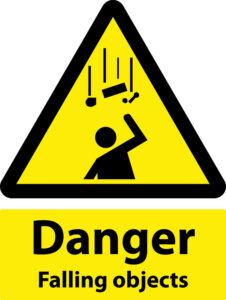1910.29 – Fall Protection Systems and Falling Object Protection- Criteria and Practices
“Safety Rail Company manufactures the SRC360 Mobile Rail: a free-standing, non-penetrating railing system that complies with OSHA 1910.28 and 1910.29, qualifying as a passive barrier between the worker and the fall hazard. This engineered fall-protection system ranks high in OSHA’s hierarchy of controls when addressing fall hazards, which prioritizes engineered solutions as the preferrable preventative action over administrative or PPE protocol. Passive barrier systems also do not require significant training or compliance protocols like those associated with administrative or active fall-protection solutions. In low-slope commercial roofing applications, the SRC360 Mobile Rail is an ideal solution for fall-hazard areas and can be left in place permanently to protect all personnel that access the roof. Safety Rail Company, 888-434-2720, www.safetyrailcompany.com
Fall protection regulations have been on OSHA’s 10 most-cited-regulations list for the past decade. In the construction industry, falls are one of the “Fatal Four:” the top four causes of construction fatalities. (The others are struck-by, caught-in/between and electrocutions.) Falls from height or on the same level are among the leading causes of work-related injuries and deaths.
From October 2020 through September 2021, federal OSHA enforcement resulted in 58 inspections of workplaces/worksites in the U.S., and 71 citations, with a total of $171,250 in penalties.
The industries most cited for violations of 1910.29 were:
- Manufacturing
- Wholesale Trade
- Retail Trade
- Mining, Quarrying
- Oil & Gas Extraction
- Construction
- Transportation & Warehousing
Major provisions of the standard
 Employers are required to protect workers from along unprotected sides or edges that are at least four feet or above from a lower level. In circumstances where they are required, fall protection systems and falling object protection must be provided or installed before any employee begins work that necessitates fall or falling object protection. In 1910.29, OSHA provides specifications for various forms of fall prevention.
Employers are required to protect workers from along unprotected sides or edges that are at least four feet or above from a lower level. In circumstances where they are required, fall protection systems and falling object protection must be provided or installed before any employee begins work that necessitates fall or falling object protection. In 1910.29, OSHA provides specifications for various forms of fall prevention.
Guardrail systems:
- The top edge height of top rails, or equivalent guardrail system members, must be 42 inches (107 cm), plus or minus 3 inches (8 cm), above the walking-working surface.
- Midrails, screens, mesh, intermediate vertical members, solid panels or equivalent intermediate members must be installed between the walking-working surface and the top edge of the guardrail system as follows when there is not a wall or parapet that is at least 21 inches (53 cm) high.
- Midrails must be installed at a height midway between the top edge of the guardrail system and the walking-working surface.
- Screens and mesh should extend from the walking-working surface to the top rail and along the entire opening between top rail supports.
- Guardrail systems must be capable of withstanding, without failure, a force of at least 200 pounds (890 N) applied in a downward or outward direction within 2 inches (5 cm) of the top edge, at any point along the top rail.
- When the 200-pound (890-N) test load is applied in a downward direction, the top rail of the guardrail system must not deflect to a height of less than 39 inches (99 cm) above the walking-working surface.
- Midrails, screens, mesh, intermediate vertical members, solid panels and other equivalent intermediate members must be capable of withstanding, without failure, a force of at least 150 pounds (667 N) applied in any downward or outward direction at any point along the intermediate member.
- Guardrail systems are smooth surfaced to protect employees from injury, such as punctures or lacerations, and to prevent catching or snagging of clothing.
- The ends of top rails and midrails do not overhang the terminal posts, except where the overhang does not pose a projection hazard for employees.
- Top rails and midrails are at least 0.25-inches (0.6 cm) in diameter or in thickness.
Guardrail systems at hoist areas and holes
- When guardrail systems are used at hoist areas, a removable guardrail section, consisting of a top rail and midrail, is placed across the access opening between guardrail sections when employees are not performing hoisting operations. The employer may use chains or gates instead of a removable guardrail section at hoist areas if the employer demonstrates the chains or gates provide a level of safety equivalent to guardrails.
- When guardrail systems are used around holes, they are installed on all unprotected sides or edges of the hole.
- When guardrail systems are used around holes that serve as points of access (such as ladderways), the guardrail system opening.
- Has a self-closing gate that slides or swings away from the hole and is equipped with a top rail and midrail or equivalent intermediate member that meets other requirements in this section.
- Is offset to prevent an employee from walking or falling into the hole.
- Guardrail systems on ramps and runways are installed along each unprotected side or edge.
Falling objects
- Employers must ensure that all openings in guardrail systems are small enough to prevent objects from falling through the opening.
- The employer must ensure canopies used for falling object protection are strong enough to prevent collapse and to prevent penetration by falling objects. WMHS
For more information:
- 29 is a robust regulation that addresses many different kinds of workplace environments that could present fall and falling object hazards. To read the complete regulation, visit: https://www.osha.gov/laws-regs/regulations/standardnumber/1910/1910.29



